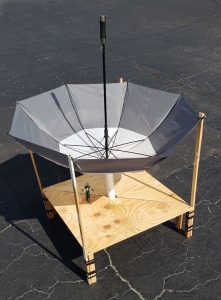California’s largest solar plant is wasteful and has incinerated as many as 28,000 birds per year over the past eight years
by Edward Ulrich, updated September 16, 2022

The wasteful and heavily government subsidized Ivanpah Solar Electric Generating Plant which opened in California’s Mojave desert in 2014 has brutally incinerated as many as 28,000 birds per year at the rate of ten per hour, but engineers are claiming that their efforts have supposedly reduced the amount of birds killed to two per hour. Nonetheless, even if the claim of the kills being reduced is true, it is still too many and the ineffective plant should be shut down.
The following points are from a Breitbart article: “California’s Subsidized Solar Power Incinerates 2 Birds per Hour”
— The Ivanpah Solar Electric Generating Plant is the world’s largest, with 350,000 movable mirrors covering 5 square miles, all reflecting sunlight onto three 40-story towers to boil water for creating electricity.
— The facility is a joint venture between NRG Energy, Google, and BrightSource Energy. It costed $2.2 billion to build, and it was subsidized with an Obama administration $1.6 billion federal loan guarantee.
— Under current regulations, Northern California’s PG&E is forced to pay a premium price of $57 per megawatt hour for solar power versus $35 per megawatt hour for power generated using natural gas. Additionally, corrupt “sustainable energy” legislation results in the plant actually being paid $200 per megawatt hour during the summer and $135 per megawatt hour during the rest of the year.
— The plant also receives huge California subsidies that include a 30 percent tax credit and a guarantee that the utilities will buy all of the plant’s electrical generation despite the actual demand on the plant.
— The plant is estimated to have killed over 28,000 wild birds in its first year, at an average of about 10 per hour. Workers refer to the birds that fly through the concentrated heat as “streamers” because they catch fire mid-air and plummet to the ground trailing smoke.
— The Audubon Society of California gathered several conservation organizations to call for the plant to close due to it violating the Migratory Bird Treaty Act, citing that the bird losses were much higher than at the Alamont Winds turbines in Northern California which killed 67 golden eagles, 80 American kestrels, 57 burrowing owls, and 172 red-tailed hawks over a recent 10-year period. [Note: More recently the global warming alarmist Audubon Society had published an article in 2017 saying, “solar power is good for birds” because it “saves them from global warming.” At the end of the article it did mention the Ivanpah plant as being “not so good for birds,” claiming that it kills seven birds per kilowatt hour as opposed to “climate change impacts of burning fossil fuels [killing] only one bird per gigawatt hour.”]
— A spokesman David Knox said the plant is trying to be proactive in testing different tactics to minimize bird deaths such as by redirecting the rays away from migratory bird paths, replacing flood lights with LED lights that attract fewer insects that birds feed on, attaching anti-perching spikes on the frames of the three towers, broadcasting loud and high pitched shrieking noises, and spraying nonlethal avian respiratory irritants that are used by farmers to protect crops. Knox said the results have been “modest,” bringing the bird kill down to about two an hour.
— In addition to the insurmountable bird killing problem, the plant’s engineers refer to it as a “dirty” resource due to it requiring a 100% fossil fuel power back-up due to the intermittent nature of it being solar power.




Also see many disturbing images of a Prairie Falcon that was burned at a similar “Crescent Dunes” solar installation in Nevada. The images show that its feathers were actually melted and the bird was still alive but could not fly.
Another Breitbart article talks about the situation as well. Following is an excerpt:
Western Watersheds Project, an Idaho-based conservation nonprofit group, has been attempting to stop the government from approving the solar plant, suing in 2011, but a California district court rejected the suit near the end of 2012. Western Watersheds has appealed the case, according to the International Business Times. Western Watersheds Project’s director, Michael Connor, said, “We know solar projects are an issue as far as birds are concerned. But they say, well, it’s not significant, so we’ll monitor it. So what happens now? You find lots of dead birds. Then what happens? Nothing ... Do we really need to have these giant plants first, or is it better to generate solar power on people’s roofs, the place it’s going to be used?”
But the California Energy Commission already is on the side of BrightSource, saying, that the plant would impose “significant impacts on the environment ... the benefits the project would provide override those impacts.”
This “CBS This Morning” news broadcast explains that the Ivanpah solar installation is acting as a “mega-trap” where the bright light of its solar collectors attracts insects which in turn attracts birds that are then burned by the heat of the reflectors.
This USGS video clip shows insects (and potentially some birds) being burned by the heat of the solar reflectors of the Ivanpah solar installation.
An entirely effective alternative exists to such harmful solar installatons
“Sterling engine” type solar power generators are the most efficient and inexpensive method for harnessing solar energy, and they have many benefits over centralized large scale solar installations that often cause serious harm to birds. A powerful personal solar power Sterling engine can easily supply all of the energy that is needed by a home.
The following article article explains the mechanism of such devices and explains ideal potential implementations of them:
“Sterling engine” type solar power generators are the most efficient and inexpensive method for harnessing solar energy, and they have many benefits over centralized large scale solar installations that often cause serious harm to birds. A powerful personal solar power Sterling engine can easily supply all of the energy that is needed by a home.
The following article article explains the mechanism of such devices and explains ideal potential implementations of them:
updated September 18, 2022






















